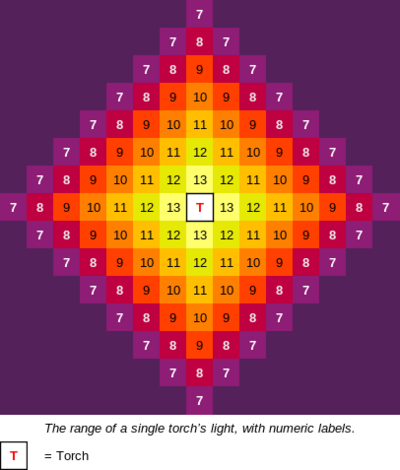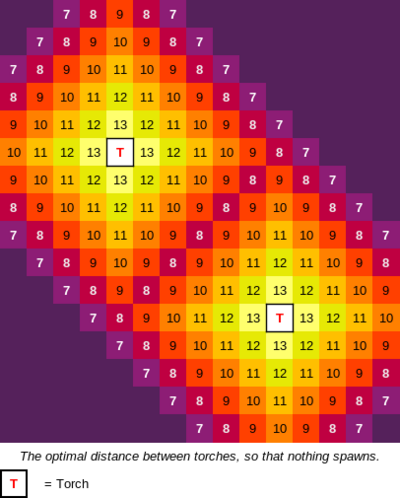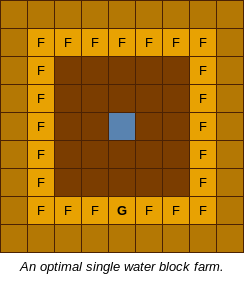Table of Contents
Survival Mode Tips
For many people, Survival is the primary mode in Minecraft. It includes a variety of gameplay mechanics, including hunger, status effects, equipment, multiple crafting stations, necessity for sleep, and so on.
There are tons of guides and pages on Survival Mode available on the Web, but the most useful to zlg make it here. They're not listed in any particular order, at least for now. 
Keep A Safe Zone
You need a Safe Zone in order to safely build and design things. Depending on which biome you're in, building a safe zone is typically achievable with laying down a bunch of torches and letting nature do the rest.
Torches emit a light level of 14. This means you need to place torches no more than 5 blocks diagonally or 11 blocks cardinally between them in order to create an efficient "blanket of light" that is light level 8 or higher. That's enough to prevent all hostile overworld mobs from appearing. However, keep in mind that Minecraft uses a 'taxi-cab' like distance calculation system. This means it counts a one-block diagonal distance as two moves, as if driving on a city street grid.
In a 2x2 mining tunnel, place torches with no more than 8 blocks between them to ensure nothing spawns! This accounts for the 2-block wide tunnel, and the far corners of the light coverage. This assumes your torches are all on one side of the tunnel.
Other mobs, like blazes, need crazy high light levels (12) to not spawn, while slimes spawn regardless, and are confined to slime chunks.
As of Minecraft Bedrock 1.17, mobs will not spawn unless the light level is zero. This makes the above diagram only relevant to older versions of Minecraft.
Clearly Label your Spawn Point
One of the easiest things to do when you first start is to build a base far away from your starting spawn point, then forget how to get to your base from the original spawn point, ruining all of your prior work!
When you first start, try to put together some torches and a simple tower of an uncommon or odd looking block will do the job. I use cobblestone or planks, about 8-10 blocks high, to mark it. I also make a sign that points in the direction of where my base is, so I never get lost from spawn.
When you come back later with more resources, you can decorate it, or even protect it so anyone who spawns is safe!
Start Farming ASAP
Soon after you make a functional shelter that gives you space to craft and store items, you'll need to establish a way to make hunger a non-issue for you. Build corrals with fences to contain cows and sheep at a minimum, to keep yourself going. Porkchops are better for combat purposes, but beef is plenty fine otherwise. You may want to add chickens to the mix, especially if you plan on using bows a lot!
Farming plants is important, too. Wheat will help you breed cows and make bread. Carrots are necessary for certain items and help pigs breed. Melons and pumpkins are nice, but don't waste too much space growing them.
The easiest farming is done with a single water source block, surrounded by up to 2 diagonal blocks of fertile soil, which darkens after tilling with a hoe. Then, you'll want to build a simple fence around it, with a gate to keep out other wildlife.
This is compact and makes good use of a single bucket of water! The dark brown blocks are tilled ground around the water source block.
The Bare Minimum
Here's a list of what's basically essential to getting to The End:
- Crafting Table
- Furnace
- Bed
- Chest
- Brewing Stand (for potions)
- Enchantment Table (if you want enchantments)
- Smithing Table (if you want Netherite gear)
- full armor and some weapons (
list the enchantments you want most against the Ender Dragon)
- At least 16 each of Ender Pearls and Blaze Powder, to create Eyes of Ender. You'll use these inside strongholds to get to The End. You will want more Ender Pearls so you can warp while in The End, but you can also get them from Endermen.
Once you get there, kill the Ender Dragon and rejoice in beating the game!
Organize your Chests!
Item organization is a key skill if you want life in Minecraft to go well. How you categorize is up to you, but I aim to have a decent amount of items in every chest, so I don't end up with one or two whole chests with extra space.
I use these categories:
- Food & Wildlife - Anything from flowers to porkchops
- Natural Resources - Mob drops, coal, other naturally occurring stuff that's not food
- Woodwork - Everything having to do with trees or wood
- Stonework - Everything stone-like
- Metalwork & Tooling - I combine iron, gold, copper, diamond, emeralds, and netherite here, as well as things you make using those materials
- Automation & Infrastructure - Redstone, railing, pistons, buttons and levers, scaffolding, etc.
- Equipment & Enchantment - Tools, enchanted books, maps, etc.
Everyone organizes their stuff differently, but I've had good results with this.


